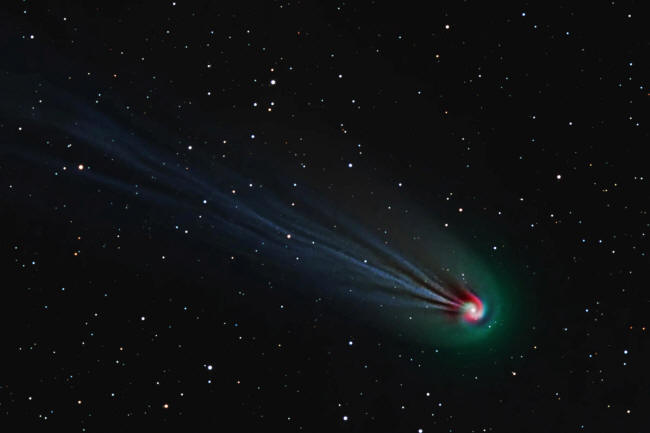|

by Meghan Bartels
March 20, 2024
from
ScientificAmerican Website
|
Meghan Bartels
is a science journalist
based in New York City. She joined Scientific American
in 2023 and is now a senior news reporter.
Previously, she spent more
than four years as a writer and editor at Space.com, as
well as nearly a year as a science reporter at Newsweek,
where she focused on space and Earth science.
Her writing has also
appeared in Audubon, Nautilus, Astronomy and
Smithsonian, among other publications.
She attended Georgetown
University and earned a master's in journalism at New
York University's Science, Health and Environmental
Reporting Program. |

An image of Comet 12P/Pons-Brooks
and its rotating core
taken by Jan Erik Vallestad.
Comet
12P/Pons-Brooks
is hiding a
strange spiral in its icy heart
and it may tell
scientists
about the
comet's innards...
Comet 12P/Pons-Brooks is a
shapeshifter...:
in the summer of 2023 it sported wings like
the Millennium Falcon, the iconic Star Wars ship.
By autumn it had been dubbed the "Devil
comet" for its horned appearance...

Source
Now, for astro-photographers with the right
equipment, Comet 12P appears to hide a perfect spiral - and the
stunning sight could tell scientists more about this particular ice
ball, which is one of the brightest comets on record.
Still, it can be tricky to observe and
photograph.
Comet 12P is trekking toward its closest approach
to the sun, set
to occur in late April, so
currently, it never rises high above the horizon and competes with
the dregs of sunlight.
"I didn't have any high expectations at all
because when I started the sessions each day, you could still
see the sunlight on the horizon," says
Jan Erik Vallestad, an
amateur astro-photographer based in Norway.
"I thought I would probably get just the
coma - a blob."
(A coma is the fuzzy-looking cloud
surrounding the icy nucleus, or core, of a comet and is created by
gas and dust lifted off its surface.)
But Vallestad got much more than a blob:
in an image taken on March 9, he captured not
only the comet's long wispy tail streaking across the sky but
also a spiral feature that he was able to highlight in editing.

Source
As bizarre as the phenomenon looks, it's real,
says Quanzhi Ye, a planetary astronomer at the University of
Maryland, who noted that he and his colleagues have also seen the
feature in Comet 12P.
The spiral is far from unprecedented:
astronomers had begun noticing that the
hearts of certain comets contained a spiral as early as 1858.
And its explanation is surprisingly simple, Ye
says.
"We know that comets release gas and dust
into space, and the nucleus is also rotating just like any
celestial object," he says.
The shed gas and dust become the coma,
which reflects sunlight and gives a comet's core its characteristic
blurry appearance.
When different parts of the comet's surface lose
material at different rates, the coma can become uneven. And
because the comet's nucleus is spinning, the brighter and fainter
parts of the coma twist into a spiral.
That formation story means the spiral isn't just pretty...
Scientists can work back in time, starting from
the visual pattern, to learn more about the comet.
"We can use spiral features like this to try
to get a sense of how fast and in what direction the nucleus is
rotating," Ye says.
"It tells us a whole lot about the comet
itself, which is pretty amazing."
Comet 12P is an exciting comet to learn more
about, he says.
It's particularly prone to outbursts of gas and
dust, which can make it appear bright in the sky.
Although the spiral pattern isn't triggered by an
outburst, Ye says, skywatchers hope the comet might undergo an
outburst in the next few weeks that could make it bright enough to
see during the total solar eclipse that will cross North America on
April 8.
In addition, this object hails from an especially interesting cohort
of comets, dubbed Halley-type comets after their most famous
member:
Source
These comets swing through the solar system once
every 20 to 200 years - Comet 12P clocks in at a 71-year orbit.
Short-period comets with orbits that are less than 20 years long
come from the
Kuiper belt region beyond Neptune.
Long-period comets with orbits that are more than
200 years long come from the spherical
Oort cloud in the cold outer
reaches far beyond.

Being able to study more Halley-type comets
could help scientists understand the area between these two
comet-laden regions, Ye says.
Comet 12P is also a witness to the ways skywatching has grown and
changed since its last pass through the inner solar system, which
occurred from 1953 to 1954, Ye says.
"Last time it was around, we didn't have so
many telescopes; we didn't have modern computers to give us this
information," he says.
This time, humans have many more observatories,
and a particularly powerful one should catch Comet 12P's retreat:
the
Vera C. Rubin Observatory
in Chile should begin its sky survey next year.
And even when the comet lurks too close to the
horizon, where science facilities struggle to observe it, amateur
astronomers around the globe are eager to monitor the ice ball and
share what they see.
"That's kind of the beauty of it all, I
think," Vallestad says of astrophotography, which he began doing
in earnest about two years ago.
"Not only do you get to create images that
can be aesthetically pretty to look at, but you can also bring
forth scientific information as well."
|





